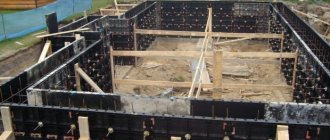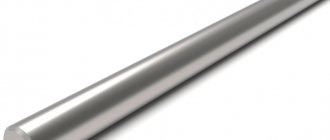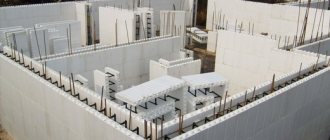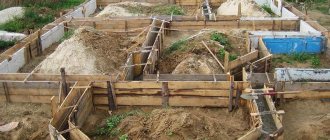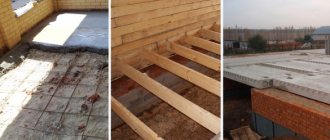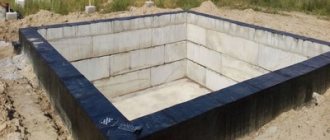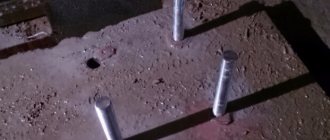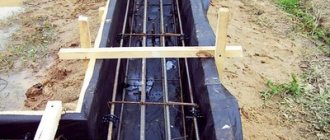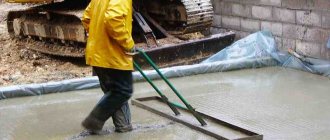What is composite reinforcement
Composite reinforcement has appeared relatively recently, but it has already received both positive and negative reviews. Some are afraid to use it in the sun and in bending ceilings, while others praise it with might and main, citing its low weight as an advantage.
So let's figure out what are the pros and cons of composite reinforcement. Can such reinforcement compete with steel reinforcement in terms of comparing characteristics and its qualities? This article was written for a construction magazine.
Types of plastic fittings
There are several types of reinforcement, depending on what material it is made from:
- Fiberglass. It began to be used back in the days of the Soviet Union. At that time, there was a rapid development of printed circuit editing in the field of radio electronics. The boards were then made from PCB. The peculiarity of this material is its woven base, bonded with artificial resin. Gradually fiberglass replaced fabric. Thanks to this, it was possible to expand the scope of application of fiberglass. They began to make furniture and household goods from it. The material has even found its place in aircraft manufacturing and the military industry. Over time, it was introduced into construction. Frames for the foundation began to be made from fiberglass reinforcement. They are suitable for conditions where other materials would deteriorate quickly. To create fiberglass, glass and epoxy resin are used.
- Basalt-plastic. This material is easier to make than fiberglass. Only basalt is enough for it. The popularity of such reinforcement is associated with its high level of strength and elasticity. It conducts less heat, but is heavier.
- Carbon fiber. This is an expensive material that requires carbon fiber and resins. The high price is due to the peculiarities of carbon fiber production. It forms the basis of the material. To obtain it, all temperature parameters and processing time must be strictly observed, since organic fibers are used as raw materials. The use of this material is possible in different areas of life. This plastic foundation reinforcement is very elastic, but the downside is its fragility. Therefore, if you plan to build a more durable and stressed structure, choose another option.
The first option is the most popular, since its price is not high and its performance properties are quite acceptable.
Advantages and disadvantages
If we compare the opinions of users and manufacturers, the following combination of pros and cons emerges. List of quality properties of composite products:
| Advantages | Flaws |
| Light weight | Insufficient tensile and tensile strength |
| Do not conduct electricity | Temperature range: from -15 to +120 °C |
| Resistant to corrosion, rotting | Excessive plasticity of the material, due to which the frame bends and moves during concrete pouring |
| Inert to moisture, solvents, chemically aggressive substances | Plastic clamps are used to secure the crosshair areas |
| Easy to install | It is impossible to form angular and curved structures |
| Easy to transport | Unknown actual lifespan |
| Not environmentally friendly material | |
| High price |
Manufacturers recommend using polymer reinforcement in the same areas as metal reinforcement (foundation, monolithic walls made of heavy concrete, etc.). However, the feasibility of such a solution is questionable. The use of products in the following areas is justified:
- Construction of walls, support pillars, partitions.
- Construction of roads, sidewalks, pedestrian paths.
- Strengthening screeds, decks, bridges.
- Production of shaped products.
- Formation of frames for greenhouses, hangars, extensions.
How to produce
Composite rods are made in three ways:
- Needletrusion. During the procedure, individual fibers are twisted into one and at the same time impregnated and braided. Since such technological lines operate at high speed, the process does not require large financial costs, which also affects the price. In order for the reinforcement to acquire a characteristic relief, it is wrapped with threads and a periodic profile. The thickness of the rods depends on the number of threads. This manufacturing method allows us to obtain products that have good adhesion to concrete.
- Plaintrusion. First, the main rod is formed, after which it is wrapped in a spiral in two directions.
- Pultrusion. This is the oldest technique. First, the fiber is formed and impregnated, and when it hardens, it is pulled through a spinneret. This system operates at the polymerization temperature of the plastic and allows the final forming and stretching of the reinforcement. The cost of the material obtained by this method is higher, and the production speed is low.
There are smooth or profiled products.
Specifications
The production of glass fittings takes place in accordance with GOST 31938-2012. The document specifies what size the products should be, their appearance, raw materials, environmental safety and other parameters.
A plastic frame, like a metal one, is used to fasten the monolith in order to increase its ability to withstand loads. This allows you to increase the service life of the building.
The functions of such reinforcement do not differ from steel, and it has the same indicators:
- The weight of the products is 0.02-0.42 kg per meter.
- The length according to the state standard should be 0.5-12 m. The parameter is measured in 0.5m increments.
Finished plastic reinforcement for the foundation must not have chips, cavities, burrs, wounds with gusts, delamination, or dents.
When reinforcing the foundation, steel rods are gradually beginning to be used more. To ensure better adhesion to concrete, they are additionally treated with sand.
Rules for working with composite reinforcement
The frame of any structure is its basis, and it is very important to fix it in a certain position - and in order for it to maintain its spatial shape, all elements must be securely fastened to each other. Since it is impossible to connect fiberglass rods by welding, only knitting remains. By the way, if you use plastic clamps for this purpose, you won’t need a crochet hook at all.
Here's what the whole process looks like step by step:
- The coil with reinforcement is unwound and cut into pieces of a given size.
- Fasteners are installed under the transverse bars of the lower level. The interval between them should be such that the rods do not bend. With a reinforcement diameter of 8 mm, this is about 80-90 cm.
- The transverse rods of the bottom row are laid out on top of the clamps.
- At the points where they intersect with the longitudinal rods, connections are made with wire or plastic ties.
- Then vertical elements are installed, due to which the upper grid is indented from the lower one. When assembling slab frames, you can use both ready-made purchased flat frames and “frog” type elements for this purpose.
- Rows of upper reinforcement are laid and tied onto the supporting elements.
- If it is a slab, the ends of the grids of rows 1 and 2 are connected with U-shaped clamps.
The nuances of assembling a slab foundation frame
The slab is a flat structure with a large area, so when assembling its frame, instead of individual rods, you can install ready-made mesh cards and connect them together. This will greatly speed up the work, but will cost more, so many contractors still assemble from separate rods.
Unlike long frames for ribbons and posts, grids for slabs are assembled locally, sometimes using nickels of the required thickness, cut from a plastic pipe, as supports. If the slab is ribbed, the frame for the protruding parts is assembled separately, according to the strip principle, and the enlarged fragments are laid in recesses dug in the ground. Only after this they begin to assemble the horizontal part of the frame, making sure to fix its outlets to the reinforcement of the ribs.
Ribbed slab frame diagram
Expert opinion Vitaly Kudryashov builder, aspiring author
Ask a Question
Fiberglass reinforcement can be combined with metal. If you don’t find frog stands or flat frames made of composite material on sale, you can easily use metal ones. The same applies to clamps, with the help of which the frames of downward-facing ribs or an upper grillage are formed.
Features of strip frame assembly
In fact, assembling the belt frame is no different from the slab. The only fundamental difference is that it has corner connections and intersections of the outer contour with the transverse walls, which need to be properly arranged. They are performed using L- or U-shaped elements, which allow for a smooth transition of reinforcement from one plane to another.
The length of these elements, which cannot be manufactured on site, but must be purchased together with the reinforcement, must be such as to ensure an overlap of at least 50 diameters of the reinforcement. If parts of a long frame can, for convenience, be assembled on a separate site, and then installed in the formwork, then the reinforcement at the intersections will have to be tied in place.
Options for connecting parts of the strip frame
Advantages and disadvantages
Plastic reinforcement has gained popularity in construction due to a large number of positive properties:
- The rods have increased strength. Even when exposed to tensile forces, the material can retain its properties.
- The price is affordable. A foundation made of plastic reinforcement will cost less than if you use metal rods.
- Small mass. This facilitates the work process and transportation of products.
- Reliability. There is no need to treat the material with protective coatings. It is not subject to corrosion and easily tolerates sea water, hydrochloric acid, and alkalis.
- Low level of thermal conductivity. The rods can be used for residential buildings, as they do not create cold dams. This allows you to create favorable temperature conditions in the room.
- Safety for the environment. During the production of products, sanitary standards are strictly observed, so they do not pose a danger to human life and the environment.
- Long service life. Reviews show that with the help of plastic reinforcement it is possible to improve the performance properties of the structure several times.
- Easy to cut and convenient to deliver to the job site. To obtain the required length of the workpiece, you do not need to use special tools.
- Can be installed without the use of welding equipment. Products are knitted with wire or special fasteners.
- They retain their properties even at temperatures of -70 degrees.
- They have dielectric properties. Thanks to this, the products are not destroyed under the influence of stray currents and have increased safety.
Experienced builders claim that plastic reinforcement is ideal for foundations.
The material also has negative reviews associated with some shortcomings of the filler. Such fittings have the following disadvantages:
- Low heat resistance. Polymer binders can withstand a limited temperature range, so plastic rods cannot be used everywhere.
- If they are heated to 200 degrees, the strength decreases and the flammability increases.
- Lower elastic modulus. When using composite rods, it is necessary to carry out special calculations to confirm the possibility of using this material for a load-bearing structure.
- If the reinforcement is constantly in an alkaline environment, then its strength characteristics will gradually deteriorate.
- Hard to bend. This material is difficult to obtain a radius shape. To achieve this you will have to resort to special technological techniques.
Reviews from builders about plastic reinforcement for foundations are quite high. Experts say that such rods:
- They have increased elasticity.
- Not subject to deformation.
- They do not require large financial outlays.
- Do not corrode.
- They do not respond to electromagnetic fields.
- No shielding.
Due to its positive performance properties, the composite is used in many fields. It is a serious competitor to steel.
Professional opinions
“As a design engineer, I often hear the same question from clients - is it possible to use plastic rods instead of steel for the foundation and how to calculate the replacement volume. Having studied the materials of some factories and tested their products, I came to the conclusion that everything depends on the purpose of use.
For example, fiberglass reinforcement with an equal cross-section is almost 3 times tensile strength than metal, but under the same load it will stretch 4 times more than steel. That is, at the base of the building it is absolutely useless; those who write negative reviews are right.
If the tensile strength coefficient of the material is of paramount importance, then you can buy ASP with a diameter 3 times smaller than steel (the so-called equal-strength replacement). Composite products will be cheaper in price and transportation. However, the problem of excessive stretching will not go away - for each linear meter under load, the length of the reinforcement increases by 2.2%, that is, by 2.2 cm. This is unacceptable for most reinforced products. It turns out that for structures under load it is necessary to take not a replacement of equal strength, but a replacement with a volume 4 times larger. The price will be too high.
There are other methods for calculating the risks of replacement, but the conclusion is clear in any case: composite reinforcing products are unprofitable and lead to a loss of structural strength, so they cannot be used to strengthen the foundation of private and high-rise housing construction.”
Dmitry, Moscow.
More information about composite reinforcing bars in the article Plastic reinforcement - cost of 1 meter.
“My construction company specializes in the construction of houses and cottages from cellular concrete, including monolithic pouring and blocks. These are aerated concrete, foam concrete, expanded clay concrete and other analogues. We have extensive experience in using composite reinforcement, as we use it to reinforce walls, but not for foundations. Plastic rods are very easy to work with, they weigh little, and can be cut with a regular knife or hacksaw. According to the technology, an armored belt should be formed every 4 rows, but the upper reinforced block (under the roof) is still made of metal for greater reliability and strength. This tactic is justified; for three years there have been no complaints from customers.”
Alexander Pashutin, Nizhny Novgorod.
“I am building a house, and to strengthen the screed, the architectural engineer who oversaw the project recommended buying fiberglass. According to him, composite plastic reinforcement is not afraid of water and has the same coefficient of expansion as concrete, so cracks are completely eliminated. I looked for information on the Internet, read reviews, and decided not to chase the cheapness, but to buy from a truly trusted manufacturer. Therefore, I ordered the products through a Galen factory dealer. It is really light, quite durable, but it breaks, so it won’t make crooked structures. At the same time, I asked the curator why the foundation was reinforced with steel and not composite. To which he offered to compare the basic characteristics of both materials himself and draw conclusions. The mesh was quickly installed under the screed and carefully poured. A month later we checked it – the screed turned out great, no complaints.”
Mark, Moscow region.
“I often come across negative reviews about composite reinforcement from those who have not even worked with it. I usually recommend using it for foundations for small, lightweight buildings. The material does not rust, is not afraid of dampness, is easy to cut and install, and there is no need to worry about proper pouring, forming a concrete pad and other protective measures.”
Valentin Shevchenko, Ufa.
“I used fiberglass reinforcement for the foundation for a small brick bathhouse. Although the building is small, changes have been noticeable in six months - multiple cracks have appeared on the lower part of the concrete strip, apparently the building has already begun to sag, because the door opens with force. I shouldn’t have been fooled by advertising, now I’ll sew up the gaps with metal strips or corners, and I’ll try to strengthen the structure with beams.”
Yakov Kuprin, Krasnodar.
Application in construction
Plastic reinforcement is used in the same way as steel. With their help they build:
- bridges;
- walls and floors;
- different types of foundations;
- fencing.
The composite is used in the production of sleepers, since concrete disintegrates under intense vibration. With its help, docks, berths, and various coastal barriers are erected. I equip shafts with such fittings and secure insulation and cladding materials.
It is not uncommon for polymer rods to replace steel parts during the construction of a frame or wooden building.
Working with different types of plastic fittings is much easier and more convenient. The process does not require large financial expenditures when compared with metal structures.
There is practically no similar material in the world. Its positive qualities allow it to expand its scope of application. It meets all the requirements of the construction process.
The linear expansion of concrete when using plastic and steel reinforcement occurs in the same way. Thanks to this, there is no risk of cracks and other deformations while pouring the solution.
Using fiberglass rods in the foundation
The use of reinforcing mesh based on glass-plastic strength elements began in the 60s of the last century. In addition, a fairly large number of buildings and technological structures made of stone and concrete have been built and are in operation, in the foundations and walls of which glass-plastic reinforcement was used. Feedback on the condition of buildings with elements of steel and glass-plastic reinforcement and many years of operating experience will give more than all the theoretical calculations of “experts” combined.
Almost everyone who makes videos or posts their opinion about the shortcomings of fiberglass reinforcement is either sales managers of competing steel products, or amateurs who confuse the causes and consequences of the basic principles of strength and rigidity of structures. For the most part, such discussions about the disadvantages of glass-plastic reinforcement are accompanied by formulas and data on the strength of steel and composites. But there are no clear reasons or processes why glass-plastic reinforcement cannot be used. If a person who has undertaken to comment on the advantages and disadvantages of glass-plastic reinforcement has not demonstrated in practice a fragment of destroyed concrete or a piece of foundation with fiberglass reinforcement, all his reasoning remains fantasies on an arbitrary topic.
Reinforcement has been used in construction, mechanical engineering, and special projects for more than 40 years. If this issue is of fundamental importance to you, refer to old Soviet textbooks from the 70s of the last century, magazines on construction topics; these sources reveal the physics and mechanics of foundation destruction processes and provide numerous examples of errors.
Possessing high specific strength, reinforcement can work perfectly in the most difficult conditions, but at the same time it has a number of disadvantages that limit its use in construction:
- The nature of composite reinforcement has almost zero ductility of the material. In human terms, a frame for a highly loaded foundation or walls made of such a rod will not be able to plastically adapt to the redistribution of load in a loaded concrete stone. As a result, in some places the building’s foundation will experience overload, which can cause cracks to appear;
- The fiberglass base takes tensile axial loads very well, but compressive loads much worse, and tolerates shear forces catastrophically poorly. This means that any transverse shearing force, of which there are many in “fresh” foundations due to sedimentary processes, will lead to destruction of the integrity of the reinforcement;
- Unfortunately, during the time that the concrete of the foundation gains strength, the fiberglass frame behaves somewhat differently, and precisely at this stage, therefore, each specific case in the arrangement of reinforcement requires a very careful and careful analysis.
Therefore, in those units where it is permissible to replace metal with a composite material, instead of the traditional eight-millimeter rod, a six-millimeter reinforcement strand can be used. Few people know, but today building slabs from stressed concrete with glass-plastic reinforcement are already being produced. But in production such material is much more expensive, so almost 90% of the range, including for foundations, are custom-made products.
Knitting features
You need to find out how to knit plastic reinforcement for the foundation in order to carry out the procedure correctly. A high-quality and reliable foundation is the guarantee that the house will last a long time. Therefore, reinforcement of the base is an important stage of construction.
Most often, strip foundations are used for buildings. For this purpose, the knitting of plastic reinforcement is carried out with some special features. This procedure helps to make the structure uniform and durable. The rods are tied at their intersections. This is done with wire or special means.
The wire is bent in the middle, after which it is put on a hook, applied to the reinforcement and tightened. This is quite difficult, so a plastic tie will help make the job easier.
Plastic shut-off valves are considered an important element of the reinforcing system. It helps to more firmly attach individual rods to each other.
Fasteners are popular among builders. These are embedded parts that create a protective layer of a certain thickness in concrete.
Such clamps are made of polyethylene. They are poured under high pressure. They provide reliable fastening of reinforcing bars, frames and allow you to obtain a strong concrete or reinforced concrete structure. Clamps are used in horizontal and vertical surfaces, and they are also used to create formwork.
Application options for glass reinforcement
An undeniable advantage of steel reinforcement is the very well predictable behavior of the metal under the most difficult loading conditions. All existing skyscrapers and high-rise buildings are built only on steel reinforcement; moreover, most of these “wonders of the world” have an internal metal frame.
Glass reinforcement is not suitable for high-rise buildings or highly loaded foundations. The structural mechanics of foundations is, in general, a whole science, primarily due to the complex interaction of individual parts of the foundation with the soil, with the walls of the entire structure.
In the existing foundation model, the most problematic areas are the corner zones, where the reinforcement experiences tensile, bending and tying loads. In these places, not every steel reinforcement is able to provide a rigid connection of corner blocks. The metal reinforcement in the foundation block achieves this only due to a combination of high ductility and elasticity. Glass and plastic reinforcement cannot be used in these foundation units. Despite its high longitudinal strength, it will not be able to withstand torsion at the corner contact point of the foundation.
The strength and ductility of glass-plastic reinforcement will be sufficient to build the foundation and basement of a one or two-story house. But provided that in the corner joints of the foundation, special couplings will be used to splice the reinforcement at right angles. Moreover, fiberglass is easy and simple to use for a simple strip foundation 70-90 cm deep.
The use of reinforcement in combination with special grades of concrete for the foundation is considered successful. Often, when special additives are used in the foundation to enhance frost resistance or water resistance, steel reinforcement begins to corrode intensively. Especially in foundations on soils with a high salt content or in close proximity to transformer substations.
In the walls of low-rise buildings, especially those made of aerated concrete block, arbolite stone and any other building material with low rigidity and contact strength, the use of glass-plastic reinforcement is even encouraged. It is much simpler and easier to work with than a steel bar.
In addition, composite reinforcement is simply ideal for attaching external insulation or laying facing bricks, where either galvanization or stainless steel is required. And, even more so, it is worth using a thin glass thread for working on the base blocks of the foundation.
Tips for choosing
Nowadays the number of manufacturers of composite reinforcement has increased, so low-quality products are found. Therefore, when choosing a material, you need to pay attention to the following nuances:
- Color. If the rods are good, then in the entire batch they are the same color. If some elements have a different color, then there was a temperature violation during production.
- Cracks and delaminations. They shouldn't exist. These defects are easy to notice on the cut.
- Fiber breaks. Because of them, the characteristics of the material are reduced. They are visible to the naked eye.
- Uneven winding. This indicates the use of old equipment and a loss of continuity.
Over time, they plan to introduce strict requirements for plastic fittings. This material can replace steel. But in order not to end up with a low-quality product, you should carefully study the characteristics.
What is composite reinforcement
Composite reinforcement is made not from steel, like its predecessor, but from basalt and glass fibers, which are bonded with a polymer base. The result is a fairly strong material that is light in weight.
The process of manufacturing fiberglass reinforcement is not so complicated. However, for its implementation it is necessary to have special equipment and strict adherence to all production modes. Composite reinforcement is divided into assembly and working; there is also distribution and reinforcement for reinforcing concrete structures.
